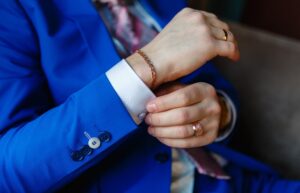Bracelet or earrings, necklace or ring, in gold or silver, with or without a stone… Jewelry is clearly no longer reserved for women. The proof here with this BonneGueule article which will help beginners take their first steps in the world of men’s jewelry.
Meeting with quentin pontonnier, jeweler-creator
Have you ever stopped in front of a jewelry store window and admired its contents? The work of art, the creativity, the imagination that certain pieces exude…
However, wearing jewelry, very little for you!
Well, this article aims to change your mind . A vast project, I agree, but I will do my best.
And for those in the know, you will surely find in these few lines, inspiration or information that can help you in your search for the perfect accessory.
I’ll tell you a secret: I’m a recent convert myself. A lover of clothing experiments, I was less so when it came to accessories. Recently, and thanks to the kindness of my fabulous friends at BonneGueule (thanks again to you), I acquired my first silver bracelet. Chilly at first, I started to wear it, to get used to it, to let myself be seduced…
I then bought new jewelry: bracelets, rings (soon necklace?), becoming fascinated by their design, the creation techniques, the symbolism they express. Because in fact, I believe that, even more than clothes, jewelry conveys an aura that is completely unique to the person who wears it.
Jewelry and men
Men’s jewelry hasn’t always been taboo. History bears witness to a certain enthusiasm among the male sex for ornaments and finery, sometimes even more demonstrative than among women.
Everywhere and for a long time, from Antiquity to the Renaissance, including the Middle Ages, men wore jewelry – sometimes very showy – to assert their social status among their peers.
Male gold pectoral worn in Egypt during Antiquity.
In ancient Egypt, all men wore jewelry. The most modest were content with small amulets while the richest wore bulky jewelry on their chests, rings (sometimes several on each finger) or cuffs in gold and various gems (turquoises from Sinai, lapis lazuli from Afghanistan).
The Romans, less extravagant, however, had the habit of wearing rings, breastplates and precious necklaces. Certain jewelry could indicate military affiliation.
From the Middle Ages to the Renaissance , each period was marked by a particular practice of ornament, both among men and women. Byzantine influence had the effect of popularizing the most sumptuous ornaments for those who could afford them. However, it was customary to wear jewelry on clothes rather than on oneself. This period saw the democratization of the clasp, also called a clasp, a sort of pin used to hold the two sides of the cape or coat.
Depending on the era, they represented flowers, animals or even mottos or coats of arms. If the most powerful ecclesiastical castes always had the habit of wearing jewelry (large gold crosses, various hierarchical rings), the secularists for their part followed the fashion of the time, often dictated by royalty.
Some sovereigns like Louis IX (very pious, also known as Saint Louis) were quite reluctant to all forms of pomp, while other kings, like Charles VI were much more fond of this type of frivolity.
Nose ornament from Western India
Nose ornament from Western India worn by an Indian prince, between 1925 and 1950: gold, diamonds, pearls and emeralds. So, where do we draw the line between feminine and masculine? Photo from the exhibition “From the Great Mughals to the Maharajahs” at the Grand Palais.
India is another striking example of a culture that has emphasized the wearing of jewelry among men. Indeed, the jewelry sector flourished there from the 14th century, at the time of the Great Mughals who personally financed this economy. These creations are among the most accomplished at the time, India enjoying particular know-how in this area as well as deposits suitable for the production of luxurious jewelry.
Emperors and local nobility adorn themselves with turban decorations, bracelets, necklaces, rings and other ornaments made of gold and precious stones. The 19th century and the advent of the British Raj (the establishment of the British colonial regime) will be a second era of great splendor for Indian fine jewelry.
Indian princes, stripped of all power, continued to assert their influence through ever more sumptuous ornaments, mixing Indian tradition and Western influence.

